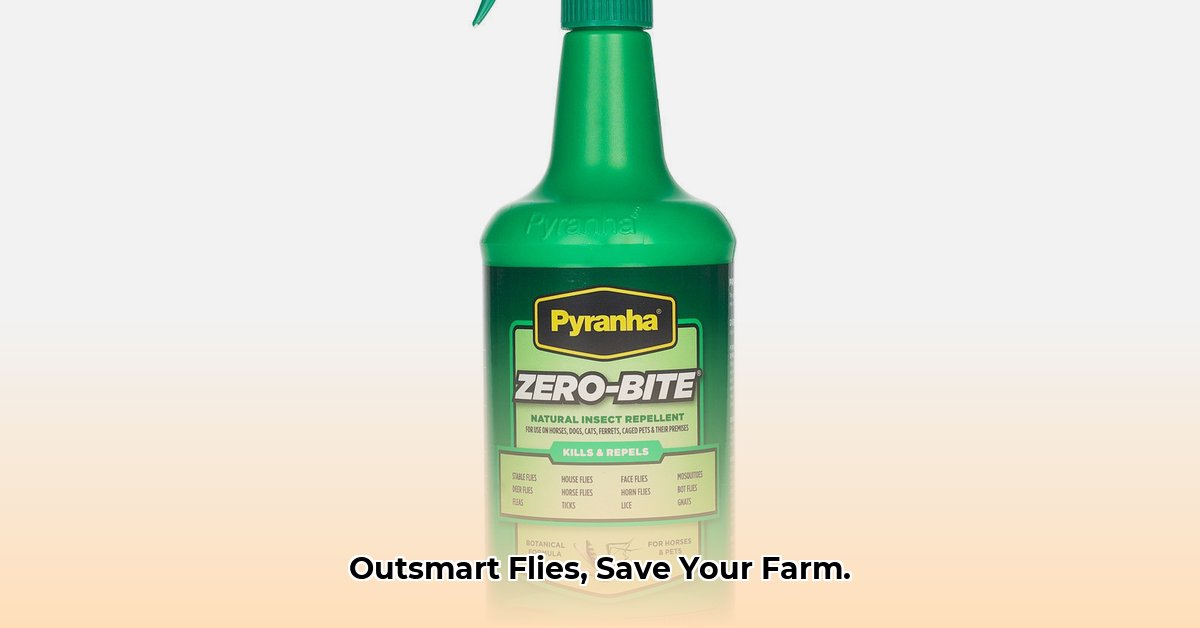
Keeping livestock healthy and your farm thriving requires effective fly control. This guide provides practical, sustainable methods for managing fly infestations, leveraging resources from Tractor Supply while prioritizing environmentally friendly practices. For sustainable manure management solutions, consider pine pellet options.
Understanding the Fly Problem: More Than Just a Nuisance
Livestock flies aren't mere annoyances; they impact animal health, productivity (reduced milk yield, weight gain), and overall farm profitability. Understanding their life cycle is crucial for effective control. Common livestock flies, such as house flies, stable flies, and horn flies, typically lay eggs in moist, decaying organic matter (like manure). These eggs hatch into larvae, pupate, and emerge as adult flies, restarting the cycle. Disrupting this cycle is key to successful fly management.
Prevention: Proactive Strategies for Fly Control
Prevention is the most effective and sustainable approach. Prioritize these steps to minimize fly breeding grounds:
Manure Management: Regularly remove and properly dispose of manure. Composting reduces volume and creates valuable fertilizer. Consider anaerobic digesters for advanced manure management (reducing odor and greenhouse gases). (Note: Tractor Supply offers manure spreaders and composting bins.)
Sanitation: Maintain impeccable cleanliness in barns, feedlots, and surrounding areas. Regularly clean water troughs and remove spilled feed to eliminate attractants.
Pasture Hygiene: Rotate grazing areas to prevent manure buildup. Well-drained, well-maintained pastures are less attractive to flies.
Integrated Pest Management (IPM): A Balanced Approach
Integrated Pest Management (IPM) utilizes multiple methods for long-term, sustainable fly control. It balances environmental responsibility with effective fly reduction, aiming for manageable populations rather than complete eradication.
Monitoring: Regularly monitor fly populations using fly traps and visual checks to track effectiveness and adjust strategies. (Note: Tractor Supply offers various fly traps.)
Biological Control: Introduce natural predators like beneficial nematodes or parasitic wasps. These biological control agents target fly larvae and pupae, reducing reliance on chemical pesticides.
Physical Barriers: Use fly screens on barns and other structures to physically prevent flies from entering.
Targeted Pesticides (Use with Caution): Chemical pesticides should be a last resort, used only when other methods fail. Always choose low-impact options and strictly follow label instructions. (Note: Tractor Supply carries various pesticides, but responsible selection is crucial.) Remember proper safety precautions like wearing protective gear.
Tractor Supply Resources: Supporting Sustainable Practices
Tractor Supply offers various products that support sustainable fly control methods. While specific product endorsements are avoided, their offerings in manure management, sanitation tools, fly traps, and potential biological control agents can be valuable resources for implementing the strategies outlined above. Always prioritize responsible selection and use of any product.
Monitoring and Evaluation: Assessing Your Success
Regularly assess your fly control program’s effectiveness through consistent monitoring. Track fly numbers over time to understand which strategies are working best. This data-driven approach informs adjustments for improved outcomes. Regularly noting fly presence is a simple, but crucial step in refining your long-term strategy.
Troubleshooting: Addressing Unexpected Challenges
Even with meticulous planning, challenges may arise.
- Resistance: Rotating control methods helps prevent pesticide resistance.
- Ineffective Strategies: Re-evaluate your approach if fly numbers remain high. Consider additional preventative measures or consulting with agricultural extension services or a livestock veterinarian for expert guidance.
Conclusion: A Sustainable Approach to Fly Control
Sustainable fly control requires a long-term commitment to a multi-pronged approach. By combining preventative measures, integrating biological and physical controls (and resorting to chemical intervention only when absolutely necessary), and consistently monitoring, you can significantly reduce fly populations while minimizing environmental impact and maximizing the health and productivity of your livestock. Remember, a proactive and adaptable approach is key to long-term success.